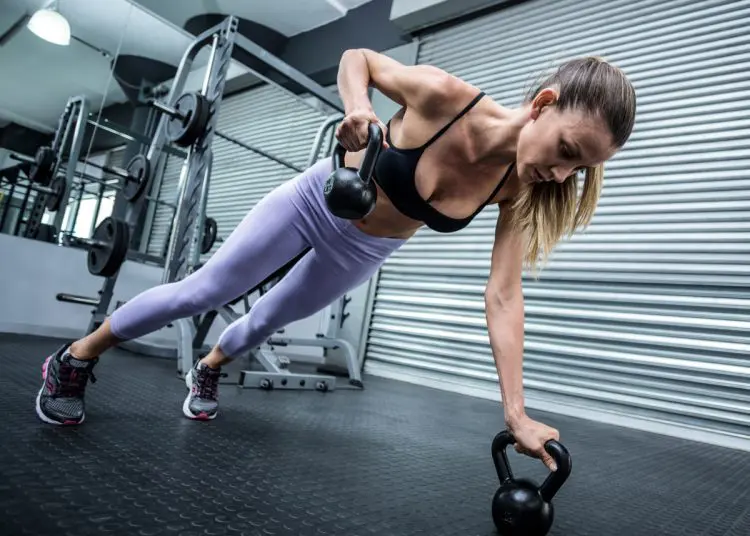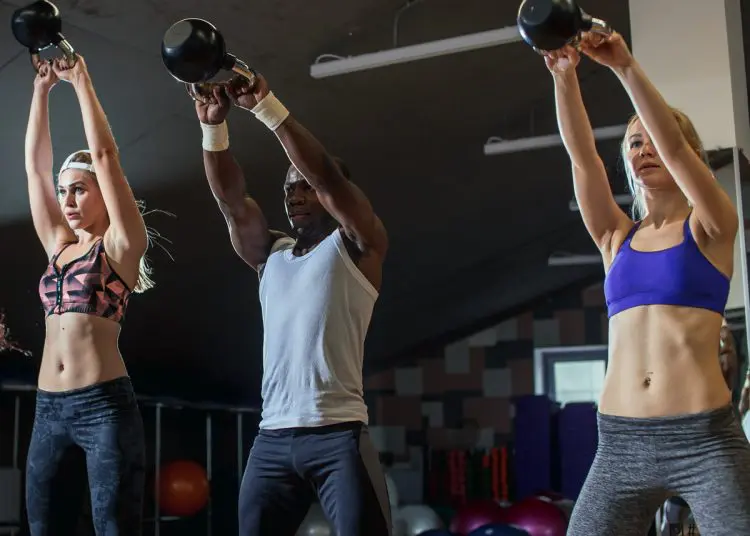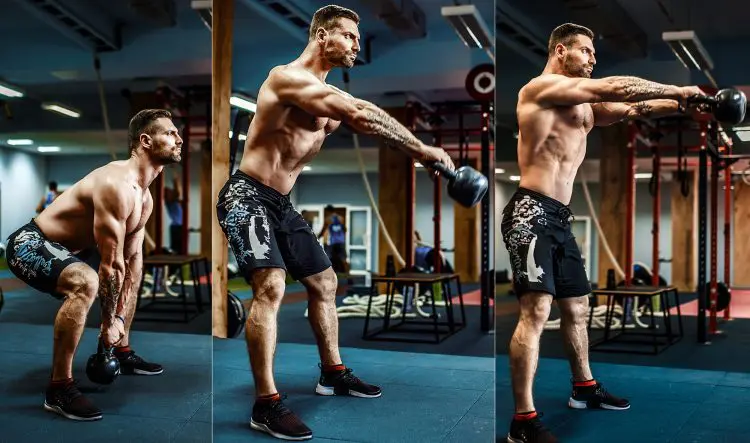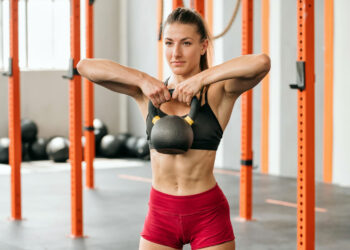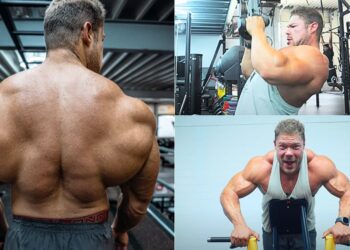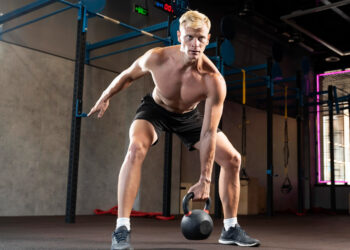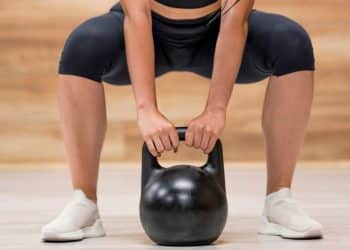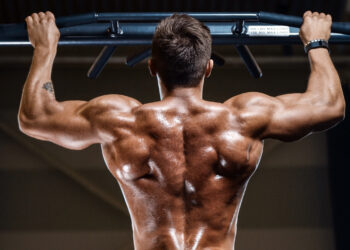Everyone loves a good chest or abs workout. After all, these are the muscles you can see in the mirror. However, the muscles on the back of your body are just as important — for functionality and aesthetics.
Focusing too much on the front of your body and neglecting the back can cause all sorts of problems, from poor posture to muscle imbalances that increase your risk of injury. Back training is a must if you don’t want to look lousy from the rear.
As a veteran personal trainer with over 35 years of experience, I’ve helped numerous people bulletproof their backs with nothing more than kettlebells. In this article, I reveal 11 of the best kettlebell back exercises and three workouts to help you transform your physique.
Recent Updates: On July 13, 2024, Fitness Volt’s Contributing Editor Andrew Peloquin (NFPT-CPT) and Senior Editor Vidur Saini (American Council on Exercise-CPT) updated the article and added actionable expert tips throughout the piece to improve the reader experience.
Level Up Your Fitness: Join our 💪 strong community in Fitness Volt Newsletter. Get daily inspiration, expert-backed workouts, nutrition tips, the latest in strength sports, and the support you need to reach your goals. Subscribe for free!
11 Best Kettlebell Exercises
While there is nothing wrong with a workout comprising barbell, dumbbell, and machine back exercises, using other training methods could be just what’s needed to keep your workouts fresh, interesting, and productive.
Spice up your workouts with the 11 best kettlebell back exercises!
- Kettlebell Renegade Row
- Elevated Plank Bent-over Row
- Unsupported Single-arm Bent-over Row
- Kettlebell Wrestler’s Row
- Single-arm Deadlift
- Kettlebell Swing
- Two-handed Kettlebell High Pull
- Single-arm High Pull
- Alternating Bent-over Fly
- Single-arm Clean
- Single-arm Snatch
1. Kettlebell Renegade Row
| Sets & Reps | Target Muscles |
| 3 x 8-12 per side | Latissimus dorsi, rhomboids, rear deltoids, core, biceps brachii, triceps brachii |
Renegade rows are not just a great back builder; they’re a superb full-body exercise! This move works your lats, mid-traps, rhomboids, and posterior deltoids and involves your legs and core too. Combine renegade rows with push-ups for a really time-efficient workout.
“This exercise is a powerhouse for building core strength and stability while simultaneously working your back muscles,” says Saini. It demands coordination and balance, making it a great functional movement.
Pro Tip: Better isolate your target muscles by imagining pulling your elbows towards your back pockets rather than simply lifting the weight.
| Difficulty | Progression | Regression |
| Intermediate | Increase weight, perform deficit renegade rows (feet elevated) | Single-arm dumbbell row from plank position (knees down) |
Check out our in-depth guide to doing renegade rows.
2. Elevated Plank Bent-over Row
| Sets & Reps | Target Muscles |
| 3 x 8-12 per side | Latissimus dorsi, rhomboids, biceps brachii, core |
While renegade rows are undeniably a great exercise, they’re not for everyone. For starters, you need two kettlebells, and you’ll also need excellent wrist strength to support your weight on one arm. This kettlebell back exercise is somewhat easier, and you only need one weight to do it. However, it’s still a very effective movement.
Saini adds that this variation makes your core and back work harder by forcing you to maintain a stable plank position while performing the row.
How to do it:
- With a kettlebell in one hand, place your other hand on a knee-to-hip-high bench or step. Keeping your supporting arm straight, walk your feet back and into a plank position. Brace your abs and let the weight hang down from your shoulders, which should be pulled down and back.
- Without lifting or lowering your hips or twisting your body, bend your arm and row the kettlebell up and into your ribs.
- Extend your arm and repeat.
- Try to do the same number of reps on each side.
Pro Tip: Maintain a neutral spine throughout the movement by actively engaging your core and glutes. This will protect your lower back and optimize force transfer through your body.
| Difficulty | Progression | Regression |
| Beginner | Increase weight, perform on an unstable surface (Bosu ball, etc.) | Bent-over row from standing position |
3. Unsupported Single-arm Bent-over Row
| Sets & Reps | Target Muscles |
| 3 x 8-12 per side | Latissimus dorsi, rhomboids, biceps brachii, core |
When most people do single-arm rows, they place their free hand on a nearby exercise bench for support. While this may mean you can lift more weight, it also takes your erector spinae out of the exercise. Work your entire back by doing this exercise without external support.
Saini recommends this exercise as it takes away your base of support, further testing your core strength and balance. It also allows for greater focus on each side of your back, addressing any imbalances.
How to do it:
- Hold a kettlebell in one hand and stand with your feet about shoulder-width apart. Bend your knees slightly for balance. Pull your shoulders down and back, and brace your core.
- Hinge forward from your hips until your upper body is inclined to about 45 degrees. Let your arms hang down from your shoulders. Do not round your lower back.
- Without twisting your hips or shoulders, bend your arm and row the weight up and into your ribs.
- Extend your arm and repeat.
- Do the same number of reps on each side.
Pro Tip: Initiate the movement by retracting your shoulder blade and pulling it down toward your hip pocket.
| Difficulty | Progression | Regression |
| Intermediate | Increase weight, use a barbell instead of a dumbbell/kettlebell | Single-arm dumbbell row on an incline bench |
4. Kettlebell Wrestler’s Row
| Sets & Reps | Target Muscles |
| 3 x 8-12 per side | Latissimus dorsi, rhomboids, biceps brachii, core, trapezius |
This exercise is very useful for those times when you only have access to light kettlebells. It keeps your muscles under tension for longer so that even light weights feel much more challenging. Like all rowing exercises, this move works your lats, mid-traps, rhomboids, and posterior deltoids. It’s done without support, so your erector spinae is also involved.
Saini highlights that this exercise is a great way to develop functional strength that translates to everyday movements.
How to do it:
- Hold a kettlebell in each hand and stand with your feet about shoulder-width apart. Bend your knees slightly, brace your core, and pull your shoulders down and back.
- Lean forward from your hips until your body is inclined to about 45 degrees. Do not round your lower back. Pull both weights up and into your ribs. This is your starting position.
- Keeping one arm stationary, lower and then row the weight back up to your side.
- Repeat on the opposite side.
- Continue alternating arms for the duration of your set.
Pro Tip: As you gain more experience, switch to the unilateral variation for better target muscle isolation.
| Difficulty | Progression | Regression |
| Intermediate | Perform on an unstable surface (Bosu ball, etc.) | Single-arm dumbbell row from plank position (knees down) |
5. Single-arm Deadlift
| Sets & Reps | Target Muscles |
| 3 x 6-8 per side | Hamstrings, gluteus maximus, upper back, erector spinae, core |
Deadlifts are one of the best back-building exercises around. They’re also fantastic for increasing total body strength. Generally done with a barbell, you can also do deadlifts with a kettlebell. Using just one weight means you’ll have to work extra hard to stabilize your spine, increasing core and lower back activation in the process.
“This exercise is a true test of unilateral strength and stability,” adds Saini. It targets the hamstrings and glutes effectively while demanding core and back engagement to maintain proper form.
How to do it:
- Place your kettlebell on the floor. Stand astride it with your feet about shoulder-width apart. Squat down and grab the handle with an overhand grip. Straighten your arm, pull your shoulders down and back, brace your hips, lift your chest, and slightly arch your lower back.
- Drive your feet into the floor and stand up, using your lats to keep the weight close to your legs.
- Lower the kettlebell back to the floor and repeat.
Pro Tip: Drive your hips back as you hinge forward, keeping your back flat and the kettlebell close to your body for greater posterior chain muscle fiber activation.
| Difficulty | Progression | Regression |
| Beginner | Deficit deadlift (stand on a slightly elevated platform) | Romanian deadlift |
6. Kettlebell Swing
| Sets & Reps | Target Muscles |
| 3 x 15-20 | Hamstrings, gluteus maximus, upper back, erector spinae, core |
Kettlebell swings work virtually every muscle on the back of your body, from the nape of your neck to your heels. As well as being an excellent strength training exercise, kettlebell swings are also a useful conditioning tool and can help you build fitness and burn fat too.
Saini explains that this ballistic movement can help build explosive power and cardiovascular endurance. It’s a full-body exercise that’s particularly effective for developing hip hinge strength.
Pro Tip: Generate power from your hips by forcefully snapping them forward at the top of the swing.
| Difficulty | Progression | Regression |
| Beginner | Increase weight, increase the height of the swing | Partial reps |
Learn how to do kettlebell swings with this informative form guide.
7. Two-handed Kettlebell High Pull
| Sets & Reps | Target Muscles |
| 3 x 8-12 | Trapezius, deltoids, rhomboids, core, biceps brachii, upper back |
Level Up Your Fitness: Join our 💪 strong community in Fitness Volt Newsletter. Get daily inspiration, expert-backed workouts, nutrition tips, the latest in strength sports, and the support you need to reach your goals. Subscribe for free!
The two-handed kettlebell high-pull is a variation of barbell sumo deadlift high-pull. Using a kettlebell makes this exercise more accessible and requires less space, making it ideal for home exercisers. High pulls work all of your back muscles, especially your traps and erector spinae.
Saini suggests that the high pull is a great way to develop explosive power in your upper body. It also activates your core and leg muscles, making it a functional exercise that improves overall athleticism.
How to do it:
- Place your kettlebell on the floor. Stand astride it with your feet about shoulder-width apart. Squat down and grab the handle with both hands using an overhand grip. Straighten your arm, pull your shoulders down and back, brace your hips, lift your chest, and slightly arch your lower back.
- Stand up quickly and use this momentum to help you pull your kettlebell up the front of your body and up to your chin. Lead with your elbows and keep them above your hands. Shrug your shoulders upwards to maximize upper trap recruitment.
- Lower the weight down to your hips, and then return it to the floor.
- Reset your core and repeat.
- You can also do this exercise from the “hang position,” i.e., with the weight at knee-height and not resting on the floor.
Pro Tip: As you pull the kettlebell up, aggressively shrug your shoulders towards your ears while keeping your elbows high to activate your traps and create a more powerful pull.
| Difficulty | Progression | Regression |
| Intermediate | High kettlebell swings | Upright row with dumbbells or resistance bands |
8. Single-arm High Pull
| Sets & Reps | Target Muscles |
| 3 x 8-12 per side | Trapezius, deltoids, rhomboids, core, biceps brachii, upper back |
Doing high pulls with one arm forces you to stabilize your spine to avoid being pulled off-balance. This increases core and erector spine activation. This option is useful for those times when you only have a light kettlebell to train with. Perform as above but use just one arm instead of two and pull the weight up to your shoulder instead of your chin.
“This unilateral variation allows for greater focus on each side of your body, helping to correct any imbalances,” underlines Saini. It also challenges your core stability more than the two-handed version.
Pro Tip: Focus on pulling the kettlebell up explosively with your elbow leading the way. This will engage more of your upper back and shoulder muscles while minimizing joint stress.
| Difficulty | Progression | Regression |
| Intermediate | Double arm variation | Upright row with a dumbbell or resistance band |
9. Alternating Bent-Over Fly
| Sets & Reps | Target Muscles |
| 3 x 8-12 | Posterior deltoid, rhomboids |
This simple but effective exercise works your middle traps, rhomboids, posterior deltoids, and erector spinae. You won’t need a lot of weight for this one; even a light kettlebell will deliver a great workout.
Per Saini, this exercise is often overlooked but is highly effective for targeting the rear deltoids and rhomboids, which can help improve posture and shoulder health.
How to do it:
- Hold a kettlebell in one hand. Stand with your knees slightly bent, feet about shoulder-width apart. Lean forward from your hips, so your upper body is inclined to about 45-degrees. Do not round your lower back. Let your arms hang down from your shoulders.
- Raise the kettlebell out and up to the side until your arm is roughly parallel to the floor.
- Lower your arm, transfer the weight to your opposite hand, and repeat.
- Continue alternating sides for the duration of your set.
Pro Tip: Keep your elbows slightly bent throughout the movement to reduce stress on your shoulder joints.
| Difficulty | Progression | Regression |
| Beginner | Use cables or resistance bands instead of kettlebells | Reverse fly machine |
10. Single-arm Clean
| Sets & Reps | Target Muscles |
| 3 x 3-5 per side | Trapezius, deltoids, core, quadriceps, hamstrings, gluteus maximus, triceps brachii, upper back |
Cleans are an Olympic lift traditionally done using a barbell. The single-arm kettlebell version forces you to stabilize your spine more and is also easier to learn. Like all types of cleans, this exercise is a total back builder.
This exercise is a complex movement that requires coordination, timing, and explosive power. Spend some time mastering the movement mechanics, recommends Saini.
- Place your kettlebell on the floor. Stand astride it with your feet about shoulder-width apart. Squat down and grab the handle with both hands using an overhand grip. Straighten your arm, pull your shoulders down and back, brace your hips, lift your chest, and slightly arch your lower back.
- Stand up quickly and use this momentum to help you pull your kettlebell up the front of your body.
- As the weight approaches your shoulder, rotate it around so that it comes to rest on the back of your forearm.
- Lower the weight back to the floor and repeat.
- You can also do this exercise from the “hang position,” i.e., with the weight at knee height and not resting on the floor.
Pro Tip: As you catch the kettlebell in the rack position, rotate your elbow under the kettlebell and drive your hips forward to absorb the impact.
| Difficulty | Progression | Regression |
| Advanced | Increase weight, perform from the hang position | Single-arm high pull |
11. Single-arm Snatch
| Sets & Reps | Target Muscles |
| 3 x 3-5 per side | Full-body, explosive power |
The snatch is another Olympic lift. It’s a tricky exercise to master, but the good news is that the kettlebell version is a lot more manageable. Like cleans (exercise number nine), kettlebell snatches work all of your back muscles.
The snatch is the ultimate test of power, speed, and coordination, and guess what? The posterior chain plays a huge role in it.
How to do it:
- Place your kettlebell on the floor. Stand astride it with your feet about shoulder-width apart. Squat down and grab the handle with both hands using an overhand grip. Straighten your arm, pull your shoulders down and back, brace your hips, lift your chest, and slightly arch your lower back.
- Stand up quickly and use this momentum to help you pull your kettlebell up the front of your body and lift it overhead in one movement.
- Catch the weight above your head, letting the kettlebell move around your wrist so it comes to rest on the back of your forearm.
- Lower the weight back down to the floor and repeat.
- You can also do this exercise from the “hang position,” i.e., with the weight at knee height and not resting on the floor.
Pro Tip: Have a firm grip on the kettlebell during this exercise. This will allow you to generate more power and control the kettlebell more effectively.
| Difficulty | Progression | Regression |
| Advanced | Double-arm variation | Single-arm high pull |
Back Anatomy
Your back is an extensive group of muscles. If you want a big, strong, healthy back, you need to make sure you train all of these muscles equally. The main muscles you need to develop to build your dream back are:
Erector spinae
This is the collective name of the muscles that run up either side of your spine. The erector spinae helps stabilize and support your lower back to prevent it from rounding. It is also responsible for the extension and lateral flexion of your spine. Strong erector spinae muscles can help prevent lower back pain.
Latissimus dorsi
Known as the lats for short, this is the large wing-like muscle located on the side of your upper back. Its functions are shoulder extension, adduction, and medial rotation. The lats give your upper back its width and help create a V-shaped torso. Well-developed lats are visible from the back AND the front.
Trapezius
The traps are a large, diamond-shaped muscle that covers much of your upper back. It’s made up of three distinct sections:
- Upper traps: responsible for shoulder girdle elevation, i.e., shrugging your shoulders.
- Middle traps: responsible for shoulder girdle retraction, i.e., pulling your shoulders back.
- Lower traps: responsive for shoulder girdle depression, i.e., pulling your shoulders downward.
Rhomboids
This lesser-known back muscle is located beneath your mid-traps and between your shoulder blades. Its primary function is the retraction of your shoulder girdle. The rhomboids don’t contribute much to the size of your back, but they’re vital for posture and shoulder girdle stability.
Posterior deltoids
While not strictly a back muscle, the posterior deltoids are heavily involved in most horizontal pulling exercises. They’re also a vital postural muscle. If you want to build the best-looking, most functional back possible, you also need to pay attention to your posterior deltoids.
Kettlebell Back Workouts
While there is nothing to stop you from just adding a few kettlebell exercises to your current bodybuilding program, you may get better results if you follow a kettlebell back workout. Design your own or use one of our tried-and-tested workouts.
Remember to spend a few minutes warming up before you begin any of these workouts. A few minutes of light cardio, followed by some dynamic stretches and joint mobility exercises, will suffice. Finish your warm-up with 2-3 light sets of the exercises you are about to do.
Workout 1: 3 x 3
In a hurry? This is the workout for you! It consists of three exercises, each of which is done for three sets. Do the three exercises as a giant set, moving quickly from one to the next. Rest 1-2 minutes between laps. In 15 minutes or less, you’ll have trained your entire back. Do 8-12 reps of each exercise.
- Kettlebell swing
- Wrestler’s row
- Incline overhead press
Workout 2: Row for glory!
This workout is all about rows. Focusing more on rows than pulldowns and pull-ups will add thickness to your upper back and could also improve your posture. Do 8-12 reps of each exercise, resting 60-90 seconds between sets. Do 2-4 sets of each exercise.
- Renegade row
- Wrestler’s row
- Elevated plank bent-over row
- Unsupported single-arm row
Workout 3: Strength and power
Use heavy kettlebells to build a stronger, more muscular back. Do 2-4 sets of 4-8 reps, resting 2-3 minutes between each one.
- Single-arm snatch
- Single-arm cleans
- Single-arm high pulls
- Single-arm deadlifts
- Two-handed high pull
Wrapping Up
There is nothing inherently wrong with barbell, dumbbell, body weight, or machine exercises. In fact, they’re all-but essential if you want to build the body of your dreams. That said, your body likes variety, and changing up your workout from time to time can help maintain your progress and avoid ruts and plateaus.
Add something new to your back-building workouts with these 11 kettlebell exercises. They’re tried, tested, and certified effective. Not convinced? Try one of our kettlebell back programs. You’ll soon discover just how effective kettlebells can be for building muscle size and strength.
Interested in measuring your progress? Check out our strength standards for Push Ups, Upright Row, Pull Ups, and more.

